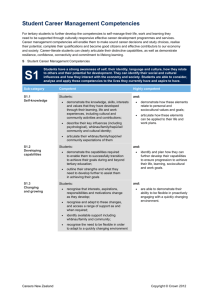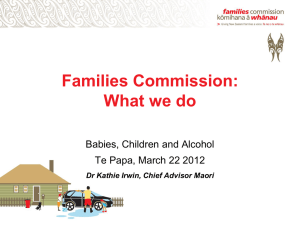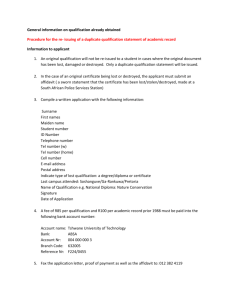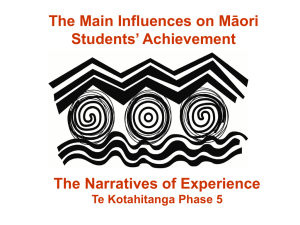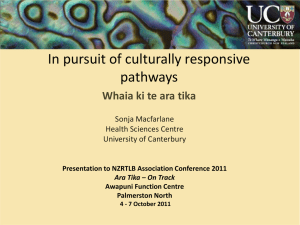Te Mana Kaitiaki o Ngā Taonga Tuku Iho (Kaupae 4) me ngā whenu
advertisement
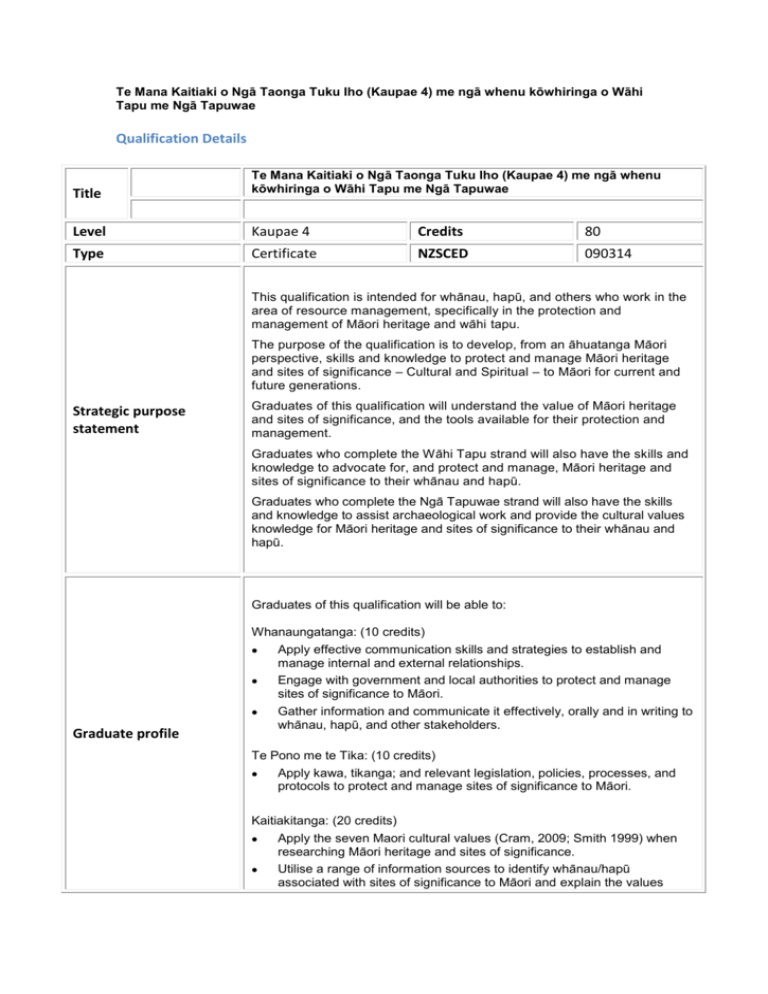
Te Mana Kaitiaki o Ngā Taonga Tuku Iho (Kaupae 4) me ngā whenu kōwhiringa o Wāhi Tapu me Ngā Tapuwae Qualification Details Title Te Mana Kaitiaki o Ngā Taonga Tuku Iho (Kaupae 4) me ngā whenu kōwhiringa o Wāhi Tapu me Ngā Tapuwae Level Kaupae 4 Credits 80 Type Certificate NZSCED 090314 This qualification is intended for whānau, hapū, and others who work in the area of resource management, specifically in the protection and management of Māori heritage and wāhi tapu. The purpose of the qualification is to develop, from an āhuatanga Māori perspective, skills and knowledge to protect and manage Māori heritage and sites of significance – Cultural and Spiritual – to Māori for current and future generations. Strategic purpose statement Graduates of this qualification will understand the value of Māori heritage and sites of significance, and the tools available for their protection and management. Graduates who complete the Wāhi Tapu strand will also have the skills and knowledge to advocate for, and protect and manage, Māori heritage and sites of significance to their whānau and hapū. Graduates who complete the Ngā Tapuwae strand will also have the skills and knowledge to assist archaeological work and provide the cultural values knowledge for Māori heritage and sites of significance to their whānau and hapū. Graduates of this qualification will be able to: Graduate profile Whanaungatanga: (10 credits) Apply effective communication skills and strategies to establish and manage internal and external relationships. Engage with government and local authorities to protect and manage sites of significance to Māori. Gather information and communicate it effectively, orally and in writing to whānau, hapū, and other stakeholders. Te Pono me te Tika: (10 credits) Apply kawa, tikanga; and relevant legislation, policies, processes, and protocols to protect and manage sites of significance to Māori. Kaitiakitanga: (20 credits) Apply the seven Maori cultural values (Cram, 2009; Smith 1999) when researching Māori heritage and sites of significance. Utilise a range of information sources to identify whānau/hapū associated with sites of significance to Māori and explain the values associated with them. Identify and explain the responsibility of whānau/hapū in the management and conservation of taonga and artefacts. Pukengatanga: (10 credits) Utilise technology to identify, record, and store information and data pertinent to sites of significance to Māori. Rangatiratanga: (10 credits) Identify and explain the rights and responsibilities of whānau/hapū to care, protect and manage their sites of significance. The Wāhi Tapu Strand: *Strand Focus – Advocacy, protection, and management of Māori heritage and sites of significance. Turangawaewae:(5 credits) Identify specific sites of significance to whānau/hapū and explain the kōrero, whakapapa, kawa, and tikanga associated with them. Kaitiakitanga:(5 credits) Apply kawa and tikanga to protect and manage sites of significance to whānau/hapū. Maintain and enhance the mātauranga held by the whānau/hapū in relation to sites of significance, for future generations. Rangatiratanga:(10 credits) Apply the concepts of kaitiakitanga, tangata whenua, mana whenua, and ahi kā roa to protect and manage Māori heritage and sites of significance to whānau/hapū. Contribute to the development of best practice models and strategic direction to protect and manage Māori heritage and sites of significance to whānau/hapū. Apply appropriate strategies to strengthen whānau/hapū, to manage taonga, and protect and manage their sites of significance. The Ngā Tapuwae Strand: *Strand Focus – Archaeological work and cultural values knowledge for Māori heritage and sites of significance. Turangawaewae:(5 credits) Identify specific sites of significance to whānau/hapū and explain the kōrero, whakapapa, kawa, and tikanga associated with them. Kaitiakitanga:(5 credits) Apply kawa and tikanga to protect and manage sites of significance to whānau/hapū. Maintain and enhance the mātauranga held by the whānau/hapū in relation to sites of significance, for future generations. Pukengatanga:(10 credits) Demonstrate basic archaeological skills and knowledge to assist in determining the archaeological and Māori values of a site. This qualification provides a pathway for those seeking to improve or further develop their skills and knowledge in Māori heritage and resource management. Education pathway Graduates may progress to Rumakihia te Taiao (Kaupae 6), Manu Taiko – Toro (Level 4), New Zealand Diploma in Māori Tourism (L5/6). Or other Level 5 mātauranga Maori qualifications, or qualifications in heritage and archaeological fields of study. *N.B. Qualification pre-requisite requirements vary dependent on the specific field of study. Employment pathway Graduates of this qualification will likely be employed as iwi monitors, Heritage advisors, conservation professionals, archaeology assistants, consultants in iwi resource management units to – planners, developers, contractors, local government, crown agencies, and iwi authorities. Community / cultural pathway This qualification provides a pathway for graduates to develop capability and capacity to protect, maintain, and enrich mātauranga Taonga Tuku Iho for Whānau, hapū, iwi/community for future and current generations. References; Cram, F. (2009). Maintaining indigenous voices. In D. Mertens & P. Ginsberg (Eds.), SAGE Handbook of social science research ethics. Thousand Oaks, California: SAGE. pp.308-322. Smith L.T. (1999). Decolonising methodologies: Research and indigenous peoples. New York: Zed Books & Dunedin: Otago University Press. Qualification Award Please provide details about the award of the qualification This qualification will be awarded to people who have met the requirements of the graduate outcomes. Credit gained for an outcome may be used only once to meet the requirements of this qualification. Awarding bodies for this qualification will be any education organisation accredited under section 38 of the Education Amendment Act 2011 to deliver a programme leading to the qualification. The certificate will display the NZQF logo and the name and logo of the Tertiary Education Organisation offering the training leading to the award of the qualification, the full qualification title, NZQA reference number, and the date of award of the qualification. If the TEO has been awarded the Mātauranga Māori Evaluative Quality Assurance (MMEQA) Qual Mark for a programme of study leading to this qualification, the certificate will also display the MMEQA Qual Mark. Review Period Please specify the period of review for the qualification 3-5 years Qualification Specification Please provide details on the following: The process for ensuring consistency of Te Mana Kaitiaki o Ngā Taonga Tuku Iho graduate profiles will be evidence-based, outcomes-focussed, and grounded in the MM EQA kaupapa Maori principles: Te Reo Māori, Tikanga, Whanaungatanga, Manaakitanga, Pukengatanga, Kaitiakitanga, Rangatiratanga, Tūrangawaewae. All Tertiary Education Organisations (TEOs) (either arranging training or delivering programmes that lead to the award of the Te Mana Kaitiaki o Ngā Taonga Tuku Iho qualification) are required to participate in a biennial consistency hui with the qualification developer. The purpose of this hui will be to confirm consistency of qualification outcome achievement by the TEO’s graduates. The system will be funded on a contributory basis. Arrangements for managing consistency The qualification developer will facilitate an initial regional hui to introduce and present the qualification. The qualification developer may appoint an external reviewer(s) to manage the consistency process, review consistency hui outcomes, and prepare a report which will be distributed to the TEOs and other relevant stakeholders. The biennial consistency hui will involve: peer review of evidence associated with graduates’ achievement of outcomes establishing a periodic cycle for the review kaupapa focus for the external consistency review. agreeing acceptable standards and/or benchmarks for qualification outcome achievement, and areas for improvement identifying issues and/or improvement opportunities associated with outcome achievement. The qualification developer considers that programme owners should be responsible for determining how to evidence the consistency of their graduates against the requirements of the graduate profile outcomes. However standard evidence for all programme providers will include details of absolute consultation with whanau, hapū, iwi that upholds the cultural and ethical values, and mana of tangata whenua when researching Māori heritage and sites of significance. portfolios of student work relating to the qualification and the annual kaupapa focus requirements of the consistency hui And one of the following: graduate and/or stakeholder/end-user feedback on outcome achievement TEO moderation outcomes which may include moderation/benchmarking across common programmes Relevant MM EQA external evaluation and review data. Māori Qualifications Services recognises the importance and value of prior learning achieved within both formal and informal settings. Processes may include: Credit transfer and recognition of prior learning arrangements recognition for people who have worked in Maori heritage settings for a period of time, or who have mātauranga Māori knowledge and skills, and have not had any formal recognition of their skills assisting people to upgrade previously gained qualifications credit for learning achieved in previously gained qualifications that aligns with outcomes in this qualification. Accredited providers delivering programmes that lead to award of this qualification must have policies and procedures in place for managing credit transfer, and assessing recognition of prior learning and recognition of current competency. These policies and procedures, and associated fees must be available to candidates prior to enrolment. Assessment standards already achieved by the candidate, which are specified in this qualification, may be credited to the qualification. Minimum standard of achievement and standards for grade endorsements (where applicable) Achieved Pre-requisites to meet regulatory body or legislative requirements (where applicable) There are no mandatory prerequisites to meet regulatory body, or legislative requirements for this qualification. Mandatory conditions for qualification Tertiary Education Organisations either arranging training or delivering programmes that lead to the award of the Te Mana Kaitiaki o Ngā Taonga Tuku Iho qualification will ensure absolute consultation with whanau, hapū, iwi that upholds the cultural and ethical values, and mana of tangata whenua when researching Māori heritage and sites of significance. Programmes leading to the award of this qualification will be evaluated using the Mātauranga Maori evaluative quality assurance (MM EQA) tools, processes, and methodologies. Optional conditions for qualification Conditions relating to specific outcomes Graduate Profile Outcome (including indicative credit values) Conditions Mandatory or Optional Whanaungatanga: (10 credits) Apply effective communication skills and strategies to establish and manage internal and external relationships. Engage with government and local authorities to protect and manage sites of significance to Māori. Gather information and communicate it effectively, orally and in writing to whānau, hapū, and other stakeholders. Optional Te Pono me te Tika: (10 credits) Apply kawa, tikanga; and relevant legislation, policies, processes, and protocols to protect and manage sites of significance to Māori. Optional Kaitiakitanga: (20 credits) Apply the seven Maori cultural values (Cram, 2009; Smith 1999) when researching Māori heritage and sites of significance. Utilise a range of information sources to identify whānau/hapū associated with sites of Optional significance to Māori and explain the values associated with them. Identify and explain the responsibility of whānau/hapū in the management and conservation of taonga and artefacts. Pukengatanga: (10 credits) Utilise technology to identify, record, and store information and data pertinent to sites of significance to Māori. Rangatiratanga: (10 credits) Identify and explain the rights and responsibilities of whānau/hapū to care, protect and manage their sites of significance Optional Optional . The Wāhi Tapu Strand: *Strand Focus – Advocacy, protection, and management of Māori heritage and sites of significance. Turangawaewae:(5 credits) Identify specific sites of significance to whānau/hapū and explain the kōrero, whakapapa, kawa, and tikanga associated with them. Optional Kaitiakitanga:(5 credits) Apply kawa and tikanga to protect and manage sites of significance to whānau/hapū. Maintain and enhance the mātauranga held by the whānau/hapū in relation to sites of significance, for future generations. Optional Rangatiratanga:(10 credits) Apply the concepts of kaitiakitanga, tangata whenua, mana whenua, and ahi kā roa to protect and manage Māori heritage and sites of significance to whānau/hapū. Contribute to the development of best practice models and Optional strategic direction to protect and manage Māori heritage and sites of significance to whānau/hapū. Apply appropriate strategies to strengthen whānau/hapū, to manage taonga, and protect and manage their sites of significance. The Ngā Tapuwae Strand: *Strand Focus – Archaeological work and cultural values knowledge for Māori heritage and sites of significance. Turangawaewae:(5 credits) Identify specific sites of significance to whānau/hapū and explain the kōrero, whakapapa, kawa, and tikanga associated with them. Optional Kaitiakitanga:(5 credits) Apply kawa and tikanga to protect and manage sites of significance to whānau/hapū. Maintain and enhance the mātauranga held by the whānau/hapū in relation to sites of significance, for future generations. Optional Pukengatanga:(10 credits) Demonstrate basic archaeological skills and knowledge to assist in determining the archaeological and Māori values of a site. Optional



